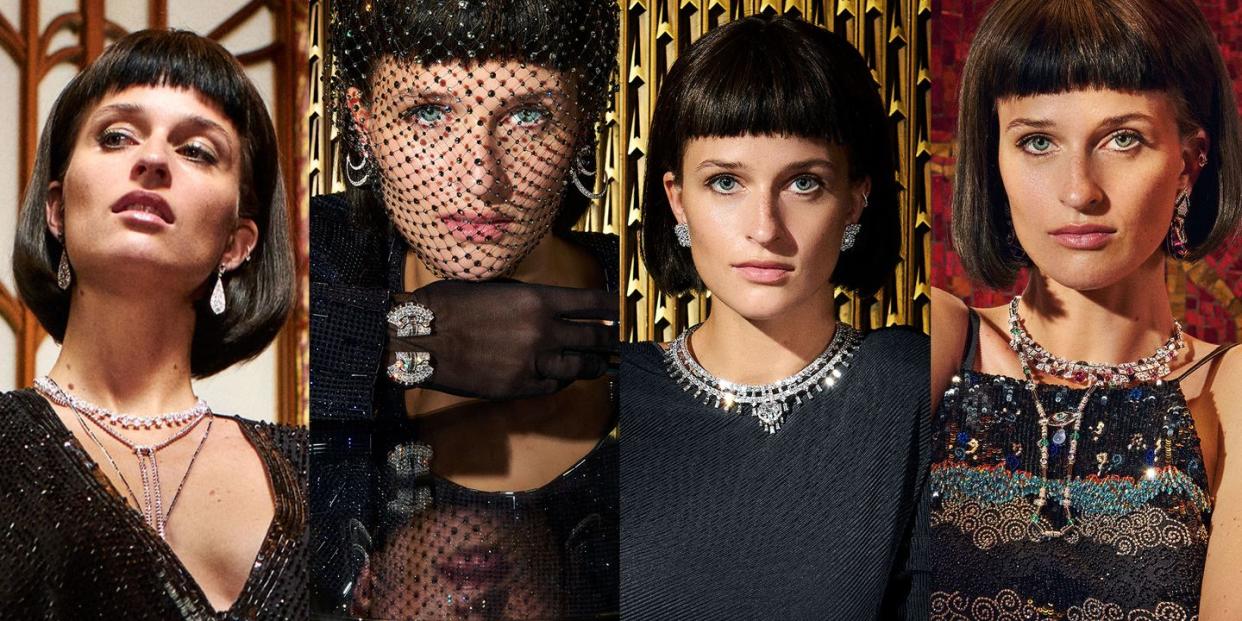Do We Dare? Art Deco Jewelry Might Make its Return

"Hearst Magazines and Yahoo may earn commission or revenue on some items through the links below."
A Cartier High Jewelry ring made of carved coral bars and an emerald center stone with a small diamond drilled into it is what finally got me to say it out loud. But the thought had been rumbling inside my head for a whole week while I looked at 2022 high jewelry collections in Paris. A white marble pebble and diamond bib at Boucheron. Those enormous Mystery Set ruby bows and the triangular emeralds at Van Cleef & Arpels. All the rock crystal at De Beers. The Messika pieces directly inspired by Howard Carter’s 1922 King Tut discovery. “Are we in some kind of new Art Deco?” I asked. Loudly.
The timing would be right. Art Deco, Charlotte and Tim Benton write in the introduction to the excellent Art Deco 1910–1939 (Bullfinch Press), is “the name given to the ‘modern’ but not Modernist 20th-century style that came to worldwide prominence in the interwar years and left its mark on nearly every visual medium.” They describe the era as one of “dramatic technological change, social upheaval, and political and economic crises, of bewildering contrasts and apocalyptic visions.” Sound familiar?

The jewels of that period clearly mark an urge to break with the past and race toward the future. The rejection of the grandly romantic style of the Belle Epoque and Art Nouveau is clear in the strong geometric lines, the fascination with the rapid rise of the machine, and the newfound access to travel visible in materials and inspiration. Creative ambition was in the air. The application for the 1925 Exposition Internationale des Arts Décoratifs et Industriels Modernes, which gave Art Deco its name, called for jewelry pieces that expressed a “modern imagination and a real originality.” And that they did. Those jewels, and others from the time, possess what historian Clare Phillips calls (in the book noted above) a “confidence of the contemporary.” I frequently cite as an example a cuff from 1930 of rock crystal tiles and an articulated hematite border by Suzanne Bel-perron for Boivin. Who would dare use such humble materials in a masterpiece today? And who would be willing to make it? The mission then was to make it beautifully, and to make it new.

That call came again in 2020, as houses began, in another moment of crisis, to plan for the future. (High jewelry collections require about two years to procure stones and to make each piece by hand.) “The thing that has always struck me is how Art Deco conveyed optimism in the face of darkness,” says Céline Assimon, CEO of De Beers Jewellers. “When the designers and I sat down to discuss the 2022 High Jewelry collection, we were in strict lockdown due to the pandemic. We desperately needed color, light, and hope. The Art Deco movement was a cultural response to the First World War, manifesting renewed appetite for life and for finding joy and optimism. This seemed an apt moment to receive inspiration from that movement’s appetite for living life boldly and exploring positive futuristic shapes. So in one of the darkest times of our modern era, we chose light as a theme.”
The result was a collection that pushed the 135-year-old maison into its next era: large black aluminum necklaces, daring use of rock crystal and diamonds. And even for those houses that were participants in the birth of Art Deco, the principles of the movement proved once again vital. At the 1925 exhibition in Paris, Van Cleef & Arpels’s Roses bracelet won the grand prize. “It was a period of high creativity,” says Nicolas Bos, Van Cleef’s CEO and president. “Our pieces from that period are significant for Van Cleef & Arpels’s style and imagination. The Mystery Set technique was patented in 1933, and a whole chapter of our collection, Legends of Diamonds, is dedicated to it. The Chevron and Atours creations, from Chapter 1 of Legends of Diamonds, are inspired by Art Deco symmetry and geometrical standards. The era will always remain a source of inspiration for our maison.”

Art Deco does indeed, as they say, have legs. Lee Siegelson, a third generation vintage jewelry dealer who has held some of the masterpieces of the era in his hands, is consistently struck by the allure the period holds for collectors. “It’s daring,” Siegelson says, “and so different from what came before. People still speak of the modernity of Art Deco. It is of the past but feels new. And it’s from a time when people, especially women, were looking to get out and wear things and show independence. That doesn’t feel so different from today. We were all locked up, and people are looking again to declare their style and their design sense. They want to be part of the movement. This level of jewelry lets them do that.”
In the top image: Giorgio Armani bolero ($8,300), skirt, and pumps ($1,295); Wolford tights ($46); Stephen Russell earrings ($25,000) and Sautoir; De Beers necklaces; Belperron cuff ($225,000) and ring ($67,500)
Photographs by Jason Kibbler; Styled by Michaela Dosamantes
Hair by Jerome Cultrera for Living Proof at l’Atelier NYC. Makeup by Linda Gradin for Chanel Beauty at l’Atelier NYC. Nails by Rita Remark for Essie. Tailoring by Susan Balcunas at Lars Nord. Model: Regitze Christensen at the Society Management. Casting by Alicia Bridgewater at Castingbya.com. Shot on location at One Wall Street.
This story appears in the December 2022/January 2023 issue of Town & Country. SUBSCRIBE NOW.
You Might Also Like